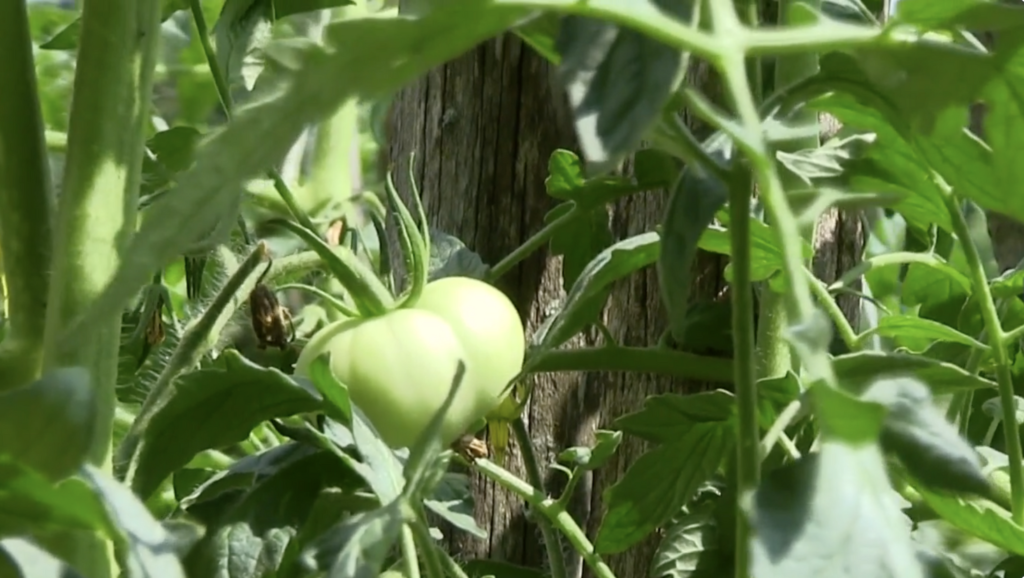
Gardening
For the descendants, gardening was a family affair—Mr. Scott and the Saylors describe how everyone would wake up early in the morning to take part in weeding, harvesting, and tending to the fields. Mrs. Stacy even remembers having to stay home from school one day to help pull potatoes. Of the descendants we interviewed, almost all recall growing up with large gardens where they raised everything from pole beans to tomatoes to zucchini.
Many descendant families have engaged in this kind of gardening since enslavement. On certain plantations, enslaved people were able to raise their own crops in small garden plots to supplement their often-insufficient rations. Not only did these gardens offer additional sustenance, they were at times a form of resistance and provided a sense of agency via something that enslaved people could own and control. Following emancipation, many formerly enslaved people with access to land continued the practice of gardening to feed their families.
As this tradition has been passed down through generations, so has knowledge about best practices for gardening. Mrs. Saylor describes the use of lime on potatoes and Ms. Eubanks mentions the use of marigolds as a pest deterrent and planting beans with corn. In every case, the descendants say their parents learned these tricks from their parents, who learned from their own parents, and beyond.
Much of this knowledge supports environmentally-friendly practices of farming. By planting marigolds alongside their crops, Ms. Eubanks’s grandfather was engaging in a natural form of pest control. This technique is a useful alternative to modern pesticides, which are quite harmful to both humans and the environment. Furthermore, the descendants’ small-scale farms are in themselves more sustainable than most of our current sources of food. They reduce reliance on industrially-farmed produce, which diminishes biodiversity and harms natural environments. The preservation and celebration of descendants’ traditional gardening knowledge can play a key role in promoting a future of healthy agriculture.
Meat
In addition to farming produce, some descendant families also raised their own animals and hunted for meat. Ms. Eubanks mentions her ancestor who was locally famous for his fox-hunting abilities. This could also be a continuation from enslavement. Along with raising gardens, enslaved people sometimes hunted and trapped small game such as fox, possum, or squirrel for additional food. Hunting knowledge was likely passed down to descendants such as Mr. Scott’s and Ms. Eubanks’s families, who used to catch deer, fox, and raccoon.
Another throughline in descendant families is the appreciation of all parts of an animal. Enslaved people were often given rations made up of “less-desirable” cuts of meat. These people and their descendants thus learned to value and innovate using every aspect of an animal, or as Ms. Eubanks describes, “everything but the squeal.” While the practice of eating less popular parts of meat was born out of necessity, it has become an integral part of many mainstream diets and celebrated food traditions.
It is also a far more sustainable form of meat consumption. Meat and dairy production currently contribute to about 14 percent of all greenhouse gas emissions. This is in large part thanks to the land used and methane released in large-scale industrial animal farming. Locally-hunted foods can be a small-scale alternative to factory-farmed meat. And in the United States, where over a third the food supply goes to waste, consuming commonly-avoided cuts of meat can prevent food loss and cut down on the amount of animals needing to be killed. Decreasing meat waste and eating organs such as kidneys and liver could even reduce livestock emissions by 43 percent.
Preserving Food and Self-Sufficiency
To handle all the meat and produce they cultivated, descendant families also passed down traditions of preserving food. Nearly every descendant family we talked to had some experience with canning, including the Moorheads, Scotts, and Saylors. Even today, when fewer descendants have access to such large farms and gardens, many continue to can. For people like Mr. Scott, canning connects them with their childhood and traditional ways of living. Additionally, each of the descendants reflected on the joy that came with having access to fresh produce throughout the year. These preservation methods are also significant for their ability to cut down on waste and reduce reliance on industrial food sources.
The combination of gardening, raising and hunting animals, and preserving food meant that many descendant families were largely self-sufficient. Mr. Scott and the Saylors each describe how they rarely went to the grocery store growing up. What ingredients a family did not grow on their own was often acquired through community sharing and trading. By raising their own food and canning surpluses, these descendants always had access to fruit, vegetables, and meat, regardless of the season.
In some ways, this self-sufficiency was born out of a lack of access—in periods following enslavement, many descendants without viable economic opportunities needed to produce their own sustenance to feed their families. Additionally, stores were sparse in rural parts of Albemarle county. But the ability of the descendants to establish their own farms and community networks reveals a strong sense of agency and independence. The resilience and innovation of these families has created valued traditions relating to food and the land. In preserving the descendants’ knowledge, future generations can continue to thrive off of sustainable, accessible, and healthy ingredients.
